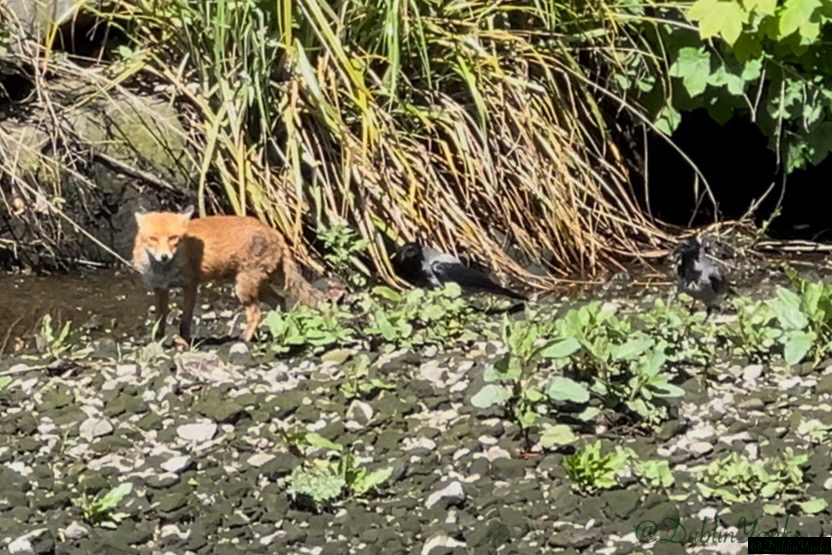Summary
I’ve been seeing red foxes near my home in Dublin’s Ballsbridge. Known as “sionnach” or “madra rua” in Irish, meaning “red dog,” they’ve lived in Ireland since the post-glacial period. They adapt well to cities like Dublin, living in dens called “earths” and eating rabbits, birds, and scraps. I saw a large fox in my car park, a cub on a sidewalk, and one by the River Dodder, where magpies were harassing it. Foxes aren’t protected in Ireland, facing threats like road accidents. They control rodents but can dig up gardens. With up to five fox families per square kilometer in Dublin, they’re a common sight.
A Fox in My Car Park: My First Encounter
I’ve been noticing red foxes near my house in Dublin. It all started when a large fox strolled through my car park in Ballsbridge. These sightings of red foxes in Dublin are becoming quite common. These foxes, known as “sionnach” or “madra rua” in Irish—meaning “red dog”—look like small dogs. They have reddish-brown fur, a white belly, and a bushy tail often tipped with white. Their pointy ears have black tips, and they weigh between 5 and 7 kilos, about 10 to 15 pounds. Males are slightly larger than females, so I’m guessing this one was a male. Some foxes have darker or silvery coats, but this one was the classic reddish shade.
Red Foxes in Ireland: A Long History
Red foxes have been in Ireland since the early post-glacial period. They likely arrived naturally. However, older theories suggest Neolithic people may have introduced them 6,000 years ago for their fur. In Exploring Irish Mammals, Tom Hayden and Rory Harrington wrote, Ireland’s red fox population is estimated at 150,000 to 200,000 annually before breeding season. In urban areas like Dublin, up to five fox families can live per square kilometer. Rural areas have about one family every 10 kilometers. This makes Dublin a hotspot for spotting these creatures. This is especially true in neighborhoods like Ballsbridge, where I live. The presence of red foxes in Dublin adds to its urban wildlife diversity.
A Skittish Cub on the Sidewalk
A few days after my car park sighting, I spotted a red fox cub standing on a sidewalk in Ballsbridge. It was skittish and ran away when it noticed me and my dog, Zeke—a 10-year-old English Bull Terrier. Fox cubs are born between March and mid-April in litters of four or five. They’re blind and deaf at birth with dark brown fur. Their eyes open after two weeks, and by one month, they explore outside, their fur turning reddish. This cub was likely just a month old. Seeing these young red foxes in Dublin indicates a thriving population.
Hooded Crows vs. a Red Fox by the River Dodder
Today, I saw another fox near the River Dodder in Ballsbridge. The fox was being harassed by hooded crows. The crows were likely protecting their nests, as foxes are known to eat birds. This fox was probably looking for a meal. Their diet includes small mammals like rabbits, birds, insects, fruit, and urban scraps. The Dodder’s banks are a great spot for foxes, with water and greenery providing a perfect habitat. If you’re exploring Dublin, you might spot foxes in similar spots. Check out more ideas in my Adventures in Dublin category.
Where Red Foxes Make Their Homes
Foxes in Ireland live in underground dens called “earths,” which they dig or repurpose from rabbit or badger burrows. In cities like Dublin, I’ve heard they use odd spaces like sheds, church basements, or junkyards. Since I’ve lived in Ballsbridge since 2024, I’ve noticed how common they are here. There are likely dens nearby in gardens or parks like Herbert Park. I’ve also heard foxes are often spotted in city parks like St. Stephen’s Green. This is a further testament to the presence of red foxes in Dublin.
Fox Behavior and Challenges in Dublin
Red foxes are mostly nocturnal but can be active at dusk or dawn. I’ve read they’re more visible during their January-to-March mating season. In Dublin, they aren’t protected and face challenges like road accidents and sarcoptic mange. This is a disease that can spread to pets. They’re not protected in Ireland due to their widespread presence and history of being hunted as poultry thieves, for sport, predator control, or pelts. Urban foxes thrive in cities like Dublin, Belfast, Cork, and Galway. They often scavenge scraps and show little fear of humans, though they run if I get too close.
The Good and the Bad of Urban Foxes
Gardeners and farmers aren’t fans of foxes. They dig up flowerbeds and lawns while hunting grubs. Farmers say they go on killing sprees in chicken coops, though they typically eat only one bird. On the other hand, foxes help by controlling rodents like rats. This is a big plus in a city like Dublin. For more on how wildlife fits into Irish life, the Irish Wildlife Trust offers great resources on local species. If you’re curious about other aspects of Irish culture, my blog has plenty to explore, from history to modern life.
Plan Your Fox-Spotting Adventure in Dublin
Spotting red foxes near my house in Dublin has been fun. If you’re visiting, keep an eye out in parks or suburban areas like Ballsbridge. Red foxes in Dublin are a unique part of Ireland’s urban landscape, blending nature with city life. Whether you’re here for the history, the craic, or the wildlife, Dublin has something for every Yank traveler.
Discover more from Dublin Yanks: American Travel Tips for Visiting Ireland
Subscribe to get the latest posts sent to your email.
